Stan Garfield's Blog, page 15
July 21, 2023
9th Annual Midwest KM Symposium, Part 4: Dan Ranta

This is the fourth in a series of posts about the Midwest Knowledge Management Symposium held June 16, 2023 at Kent State University. This post is about the second presentation in Track 2 (Technology and Digital Transformation) delivered by Dan Ranta, who traveled from his home in Guatemala to give his talk.
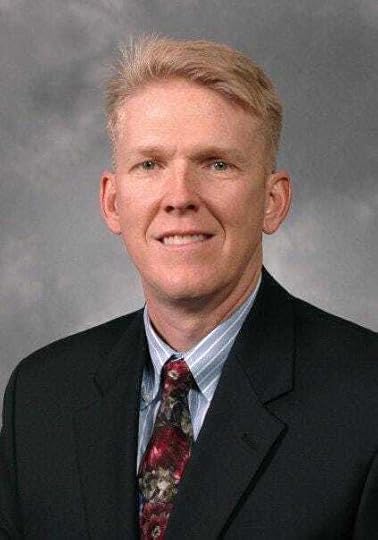
Daniel Ranta has 25+ years of experience in KM strategy, collaboration, content management, portal design, social networking and measuring business results. He has worked as a KM Leader for large, global companies and as a consulting practice leader in KM. His experiences across industries in understanding corporate challenges and cultures and accelerating the movement from strategy to action are well known and often written about in the KM space. He is currently a KM advisor and consultant.
Transforming Existing Communities: Chasing Context Using Text Analysis and SNA presented by Dan Ranta
Dan covered the following topics in his talk:
Challenges and gapsPeople: Recognition of contributors and brokers is the acceleratorTaxonomy: Expertise/Experts and Capabilities/CompetenciesUncovering business pain pointsUser experience leverages and clusters expertise based on skillsCollaborative technology organizes knowledge and disseminates to solve problemsConnections lead to the end game: a learning organization across the value chain with networks of people sharing knowledge that is mission-minded and purposefulHe made the following key points:
KM is fundamental to going digital.Leadership + Behavior = Purposeful Collaboration.Tacit knowledge is always more important than Explicit knowledge.World class communities with governance are central to designing and implementing KM in the workplace.Governance of context defines how to balance the formal (e.g., Adaptable Communities, Agile Interactions, Collaboration, Innovation) and informal (e.g., Frameworks. Roles, Methodologies. Processes) types of knowledge.Sharing tacit knowledge helps employees handle situations that do not fit cleanly into established processes and structures.Text analysis of CoP discussions helps define a taxonomy of capabilities and competencies.Users can suggest new topics for the taxonomy.SNA reveals knowledge brokers already doing the work so they can become CoP leaders on a local level.Dan provided an example of analyzing connectivity of CoP members using Social Network Analysis (SNA) to answer the question: What if the top 10% of knowledge brokers left the company? A sociogram showed that a serious amount of connectivity would be lost.
He described applying a multidisciplinary approach to construct the Platform CoP taxonomy:
Step 1: Use text analysis to do heavy lifting from a corpus of plain text like a CoP discussion extract.Step 2: Once the text analysis is completed, we corroborate the pre starter taxonomy using CoP expertise/experts.Step 3: The new/refreshed CoP is launched, and we continue to listen to CoP membership who makes taxonomy recommendations that are reviewed and approved by CoP leadership.Every CoP member is asked to nominate expertise (not experts):
Expertise is a domain of fundamental knowledge that you have acquired through application, experience, and/or studies. It’s what you know about.Experts are officially designated authorities in sanctioned areas of expertise.The same errors kept coming up, resulting in the same questions being asked in the community over and over. So before asking questions, the KM team encourages community members to search for existing questions. Questions are resolved and then marked with a checkmark. The acronym FAST promotes the desired behaviors:
Find: Seek trusted, validated knowledge content (self-service)Ask: Ask an expert; peer-to-peer problem solving (Network Discussions}Share: Contribute what you knowTrust: Develop trusted, global relationshipsDan views the end game as the transformation of organizations through these stages:
HeroSystemsNetworkedFearlessLearning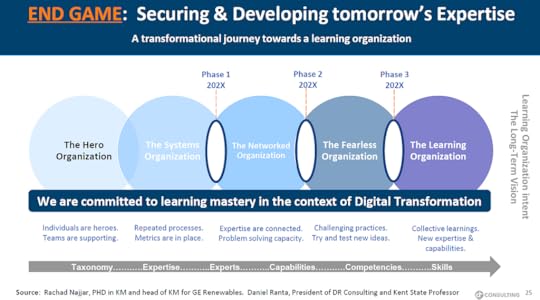
As usual, Dan’s presentation was filled with practical advice and examples. He has been a frequent contributor to the SIKM Leaders Community. You can read his posts and view his presentations and facilitated session:
2013–06 Knowledge Sharing at ConocoPhillips 2017–11 Collaboration at GE 2019–11 Building a Collaborative Culture at GE (with Rachad Najjar) 2021–11 Fishbowl Session: Measuring Successful Knowledge Sharing (with Nancy Dixon, Chris Collison, Robert Taylor, Tom Short. and Andrew Muras) 2022–09 Creating Strategic Alignment to Drive Purposeful Collaboration (with Arielle Band)Part 5 of this series will feature Rajesh Dhillon. Part 3 featured Valdis Krebs.
[image error]July 14, 2023
9th Annual Midwest KM Symposium, Part 3: Valdis Krebs

This is the third in a series of posts about the Midwest Knowledge Management Symposium held June 16, 2023 at Kent State University. This post is about the first presentation in Track 1 (People and Processes) delivered by Valdis Krebs, who was presenting at his third Midwest KM Symposium.
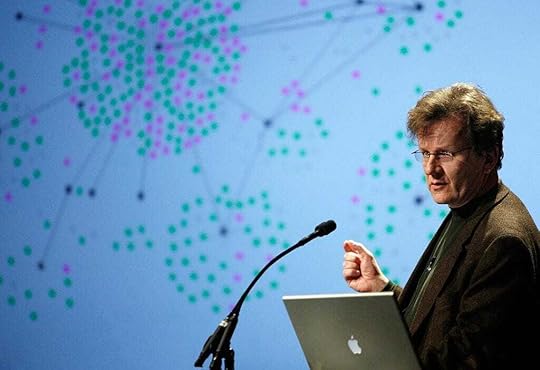
Valdis is a data scientist who specializes in social, relational, data analysis and visualization to help clients understand our organizations and communities in a world of complex/entangled knowledge flows, human interactions, exchanges, and influence.
He is a network scientist, who uses data mining, social network analysis, pattern discovery and artificial intelligence (AI) to assist a worldwide client base. He developed the popular InFlow software and many other unique algorithms for discovering patterns in human networks.
Before starting his own business, Valdis held various HR management positions at The Walt Disney Company, TRW Space & Defense, Ford Motor Company, and Toyota USA. Valdis works from his office in Cleveland, Ohio with a network of colleagues and collaborators around the world.
Valdis has been cited thousands of times in academic publications, patent applications and court documents on network analysis, network visualization, organizational networks, community networks, and covert/criminal networks. His work also appears in dozens of business books.
Knowledge Serendipity — Networks, Conversations, and Interactions presented by Valdis KrebsValdis started by defining Social Network Analysis (SNA) as the mapping and measuring of relationships, interactions, and flows between people, groups, organizations, computers, and other connected information/knowledge processing entities. The nodes in the network are people and groups while links show relationships, flows and interactions between nodes. SNA provides both a visual and a mathematical analysis of how complex human systems work
He then asked what leads to organizational success. “Is it who you know, or what (KEA: Knowledge, Experiences, Abilities) you know?”
His answered the question as follows:
It’s who you know + what you know
AND
It’s who you know that knows what!
AND
It’s who you know that knows who that knows what!
Valdis suggested that those who are one, two, or three steps away from you comprise your network neighborhood, and that those who are four, five, or six steps away don’t matter. Serendipity usually happens with those in the green and blue nodes as pictured here:
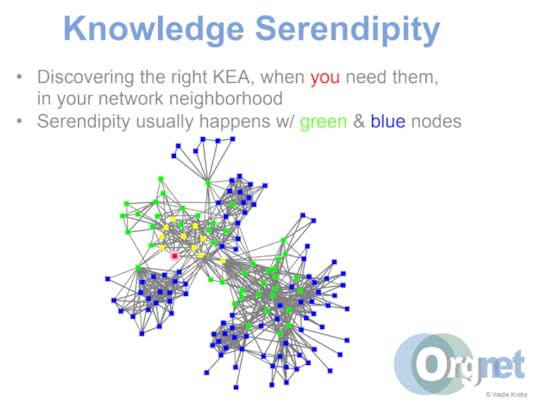
He explained that Measuring Organizational Diversity (MOD) slowly morphed into mapping and measuring organizational knowledge sharing. He went on to offer examples, including a corporate project problem, a non-profit strategy problem, a corporate strategy problem (the Apple iPod), and how COVID-19 drove drug discovery.
Unfortunately, Valdis ran out of time before he could present his conclusions from the stories he told. However, this provides me an opportunity to offer them here.
What needed to come together?Innovation is usually a new mix of what we already know and what we don’t know — yet.Knowledge and ideas are not all in the right place at the right time, or stored in a database, waiting for innovation to happen.Different people from different disciplines need to discuss ideas and knowledge from their diverse perspectives. Connect on your similarities and benefit from your differences.Most successful teams in research and business have a mixture of people that have experience with each other, and new members to the team. Too much similarity, or too much difference never succeeds as well as the right mix of both.Prior successful experiences and trusted collaborators get reused in new projects of similar, yet different needs.Lessons LearnedYou never know what knowledge you will need until you need itKnowledge does not arrive pre-packaged, ready for use. Context is key, it determines what ideas and knowledge are involved and who is involved to make sense of what is happening and what may beConnections matter! Often the non-obvious ties in our networks are keyknowledge holders, sense-makers. Their experience is necessary to work our current context.Sometimes we forget our ideas, or even what we know. Someone in our network re-ignites those dormant thoughts and helps us piece them together. What is necessary bubbles to the surface, when it is needed. Can’t predict the future, but you can prepare for it!Network LessonsNever lose a good tie; stay connected, even if they are far away. Distance can create opportunities!Serendipity usually happens in your 2 & 3 step network neighborhoodNeed both similarity and differenceBut not too much of eitherYour network must be a good combination of Reach and Redundancy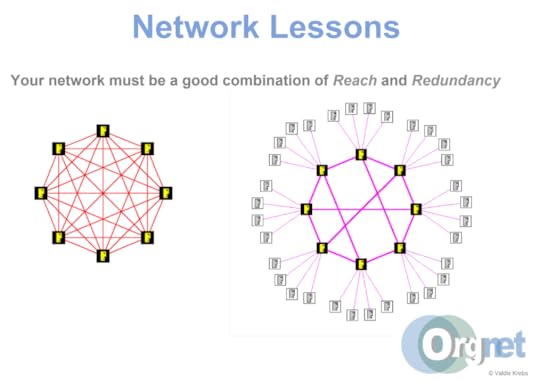
The final slide in Valdis’s presentation contained this quote:
“What makes societies work are the interactions among us” — Albert-Lászlo BarabásiAfter the symposium I asked Valdis if he would like the chance to present the full talk on a future SIKM Leaders Community call. He agreed and is currently scheduled for a year from now on July 16, 2024, although this might change if an earlier slot opens. For more about Valdis Krebs and his work, see my Profile in Knowledge.
Part 4 of this series will feature Dan Ranta. Part 2 featured Zach Wahl.
[image error]July 13, 2023
Bill Kaplan: Profiles in Knowledge

This is the 93rd article in the Profiles in Knowledge series featuring thought leaders in knowledge management. Bill Kaplan is an independent knowledge management practitioner, consultant, coach, advisor, trainer, author, and speaker based in Camas, Washington. His approach to KM is business-focused, non-academic, and practice-based, evolved from 20 years of KM solution planning and delivery. He focuses on “Creating Value from Knowledge” throughout the workplace as part of the way the work gets done. This includes dealing with knowledge capture, sharing, and retention challenges by mitigating and preventing knowledge loss due to workforce turnover.
I have known Bill for many years and often see him at the KMWorld Conference. He has been an active member of the SIKM Leaders Community since 2009, frequently replying to queries. We recently worked together as part of the Midwest KM Symposium planning committee, both presenting at the 2023 event held at Kent State University.
Background
Bill is the Founder of Working KnowledgeCSP, an independent, internationally recognized knowledge management consulting company. CSP stands for Concept | Strategy | Practice. After a 25-year USAF career, Bill served as the Chief Knowledge Officer and Knowledge Management Practice Manager at Acquisition Solutions, Inc. (ASI), a public sector focused management consulting company. Under Bill’s knowledge leadership, ASI earned Top 20 North American Most Admired Knowledge Enterprise (MAKE) recognition from Teleos in 2007, 2008, and 2009. Prior to that, he was the Deputy Global KM Practice Manager at SAIC. CIO Review recognized Working KnowledgeCSP as one of the “10 Most Promising KM Solution Providers of 2018 and 2020.”
Bill holds a BS in Business and Economics from Lehigh University, an MBA from Southern Illinois University at Edwardsville, and a Professional Degree in Engineering Management with a concentration in Knowledge Management from The George Washington University. He previously taught KM as an adjunct professor in knowledge management at the University of Maryland, Global Campus.
EducationThe George Washington University — Professional Degree, Engineering Management/Knowledge Management, 2006–2010Dwight D. Eisenhower School for National Security and Resource Strategy — NSM, National Security Policy and Research Studies, 1992–1993Southern Illinois University Edwardsville — MBA, Management, 1979–1980Lehigh University — BS, Business and Economics, 1969–1973ExperienceWorking KnowledgeCSP LLC — Founder and Principal Consultant, 2009 — presentUniversity of Maryland Global Campus — Adjunct Professor (Knowledge Management), 2018–2021ASI (Acquisition Solutions, Inc.) — Chief Knowledge Officer and KM Practice Manager, 2005–2009SAIC (Science Application International Corporation) — Deputy KM Practice Manager, Senior Consultant-Knowledge Management and Senior Consultant-Government Acquisition Policy and Process, 1998–2005United States Air Force, 1973–1998ProfilesAboutHighlightsLinkedInContentBlogLinkedIn PostsRealKMTwitterArticlesKnowledge Management: Leveraging the “Electrome” or “Learning at the Speed of Knowing”US Climate Change Mitigation Strategy Requires System Thinking and Defined RequirementsKnowledge Management and Critical Thinking: Congress, Legislative Outcomes and Systems ThinkingKnowledge Management: Lessons Learned and Design Thinking — Crafting an Environmentally and Economically Balanced “Fit for Purpose” National Energy PolicyKnowledge Management: “… each man is my superior, each woman also my superior, in that I may learn from him and her”The Incoming Administration: Transition, Decision Making, and the Value of Knowledge ManagementPeople, not Technology, Are Always the Foundation for KM SuccessCommunities of Practice (CoP) in International Financial InstitutionsKM and Evidenced Based Collaboration: a Solution for the Partial US Gov’t ShutdownKM ISO Standard: Progress Towards Accredited KM Certification ??3 Assumptions That Might Be Sabotaging Your KM EffortsThe Challenges In Building a KM Program in the Federal GovernmentKnowledge Management (KM) and US Talks with North Korea (NOKO)CoP Success and the Concept of Shared ValueNo Time for KM in Times of Change?Context Puts a Face on Knowledge and Lets You See Inside5 Reasons You Can’t Get the Go Ahead for Your KM Effort!The Long Term Value of Current Content and Knowledge Sharing: Your RelevanceAgile Knowledge Management: How to Rapidly Develop a Sustainable Knowledge Transfer Capability While Increasing PerformancePractice-Based KM Maturity ModelCommunity of Practice (CoP) Maturity Model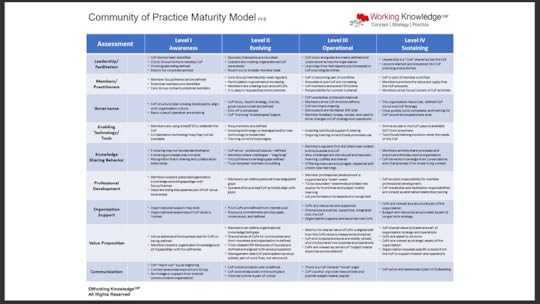 Value Creation from Knowledge
Value Creation from Knowledge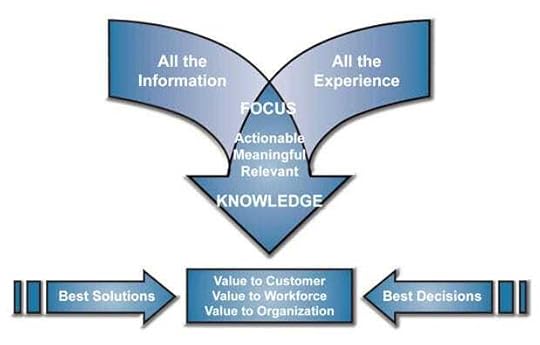 Knowledge at the Point of Execution®
Knowledge at the Point of Execution®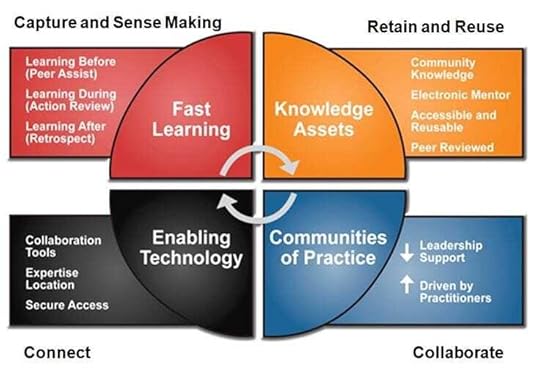 KM Framework
KM Framework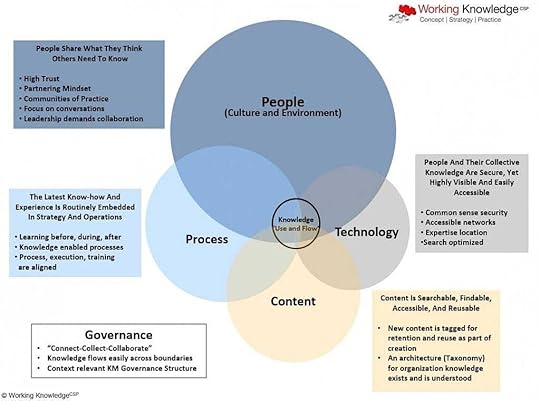 Knowledge Enabled OrganizationsLinkedIn ArticlesKnowledge Management: Requirements Definition, Consensus and Lessons Learned in Delivering The Equality Act (2021)Knowledge Management: “Performing and Learning”: Lessons from 2020 for a National Voting StandardWhat Does Good Policing Look Like and How Does a Community Define It? The Value of User Stories and Use CasesKnowledge Management and the Plans to Return to Campus: Learning to Create Value from Other People’s KnowledgeLearning Not Blame: “Inquiry” Not “Inquisition”Operating “Faster Than the Speed of Change”: Creating Value from State Knowledge in the Fight Against COVID-19NY Governor Andrew Cuomo: “Creating Value from Knowledge”The Evolving Knowledge Management (KM) ISO Standard Is Your Friend, But You Need to Place the Standard in Context!Communities of Practice: Reflections of KM VersatilityAgile Knowledge ManagementProgram Management: Improving Knowledge Capability to Mitigate Operational Risk in Program ExecutionThe Knowledge Manager: Key to Creating Value From Your KnowledgeKnowledge Leadership, the News Media, Trust, and Enabling Learning Lessons in BaltimoreCreating Value from Knowledge: The Chief Knowledge OfficerKnowledge Management vs. Knowledge LeadershipMeasuring the Unmeasurable: Part 1, Part 2, and Part 3Practically Speaking, Does Professional Certification in Knowledge Management Exist? Part 1…Yet? and Part 2: How Will You Know It’s Real?Concept and Practice
Knowledge Enabled OrganizationsLinkedIn ArticlesKnowledge Management: Requirements Definition, Consensus and Lessons Learned in Delivering The Equality Act (2021)Knowledge Management: “Performing and Learning”: Lessons from 2020 for a National Voting StandardWhat Does Good Policing Look Like and How Does a Community Define It? The Value of User Stories and Use CasesKnowledge Management and the Plans to Return to Campus: Learning to Create Value from Other People’s KnowledgeLearning Not Blame: “Inquiry” Not “Inquisition”Operating “Faster Than the Speed of Change”: Creating Value from State Knowledge in the Fight Against COVID-19NY Governor Andrew Cuomo: “Creating Value from Knowledge”The Evolving Knowledge Management (KM) ISO Standard Is Your Friend, But You Need to Place the Standard in Context!Communities of Practice: Reflections of KM VersatilityAgile Knowledge ManagementProgram Management: Improving Knowledge Capability to Mitigate Operational Risk in Program ExecutionThe Knowledge Manager: Key to Creating Value From Your KnowledgeKnowledge Leadership, the News Media, Trust, and Enabling Learning Lessons in BaltimoreCreating Value from Knowledge: The Chief Knowledge OfficerKnowledge Management vs. Knowledge LeadershipMeasuring the Unmeasurable: Part 1, Part 2, and Part 3Practically Speaking, Does Professional Certification in Knowledge Management Exist? Part 1…Yet? and Part 2: How Will You Know It’s Real?Concept and PracticeThe Knowledge Edge Series
Understanding KMKM Concept, Strategy, and PracticeKnowledge LeadershipKM Concepts: Fundamentals of a Knowledge Enabled OrganizationOne View of KnowledgeHigh Performing Knowledge Enabled OrganizationsFast LearningCoPs (Part 1)CoPs (Part 2)Knowledge AssetsKnowledge at the Point of ExecutionDeveloping Knowledge Workers Through Senior Management LeadershipOperationalizing LearningUnderstanding KM CertificationArticlesReplacing Risk with Knowledge to Deliver Better Acquisition OutcomesKnowledge is the Source of Better Acquisition OutcomesCapturing, Retaining, and Leveraging Federal Agency Workforce Knowledge — ATSDLeveraging Our Critical Acquisition KnowledgeDeploying a Knowledge Convergence Framework: Four key elements for building a performance learning cultureCreating a Sustainable KM Framework: The Concept | Strategy | Practice | (CSP) Model CSP ModelArticles by OthersInterview: Bill Kaplan on Knowledge Loss and Employee Turnover by Mimi DionneHow Technology Will Affect the Future of Knowledge Management by Lauren TreesConnecting the dot.govs by Steve BarthAlternatives to definition by Dave Snowden2016 election: an opportunity to reset knowledge management by Meredith SomersCIO ProfileSIKM Leaders CommunityPosts
CSP ModelArticles by OthersInterview: Bill Kaplan on Knowledge Loss and Employee Turnover by Mimi DionneHow Technology Will Affect the Future of Knowledge Management by Lauren TreesConnecting the dot.govs by Steve BarthAlternatives to definition by Dave Snowden2016 election: an opportunity to reset knowledge management by Meredith SomersCIO ProfileSIKM Leaders CommunityPostsBill’s tribute to Melissie Rumizen
I worked closely with Melissie Rumizen while she was with the KM consulting team led by Kent Greenes at the original SAIC. One key learning for me from Melissie was her perspective that there is no “perfect KM Strategy” for an organization. The idea that the strategy should and will develop through practical application and “performing and learning” in the job and on the job is a fundamental that anchors much of my current approach to KM consulting. I still refer to my copy of the book with her inscription to me on a regular basis. I visited with her in her home in Fairfax, VA shortly before she passed away…she gave me some advice and it is in this inscription. Melissie told me KM was not an easy discipline with which to work, and if I was to stay with it, I needed to be always a “source of learning” for my colleagues and my clients. Melissie was and remains, through her thinking and writing, a real practitioner in the field.
Presentations
2009–06 Managing Knowledge Loss Due to Workforce Attrition — Slides2014–07 Losing Your Minds: Capturing, Leveraging & Retaining Organizational Knowledge — Slides2016–02 Agile KM — Slides2019–02 The Value of CoPs in International Financial Institutions — SlidesPresentationsPractice-Based KM Maturity ModelCommunity of Practice Maturity ModelKM Framework7 “Must Know” KM Fundamentals to Implement Knowledge-Based Contract ManagementStrategic and Critical ThinkingSlideShareConferencesKM Showcase2019 — Communities of Practice — Shared Value2020 — Knowledge Management is Easier to Deliver as a Slogan than as a Sustainable InitiativeKMWorld2015 W3: Applying ‘Agile’ in Developing KM Strategies & Implementing Frameworks2010Replacing Risk With Knowledge in Program Operations — SlidesKnowledge Loss Strategies — SlidesNASPOManaging the Risk of Knowledge Loss Due to Workforce AttritionDoD and Federal Knowledge Management Symposium2019 The Key to KM and Digital Transformation is Not TechnologySLA2021 Developing, Implementing, and Resetting a KM Strategy in a Time of UncertaintyKMGNKMAgile — KM Strategy Development “Faster than the Speed of Change”Midwest KM Symposium2023 Knowledge Management Made Simpler, But Not Necessarily Easier! Lessons from KM in Practice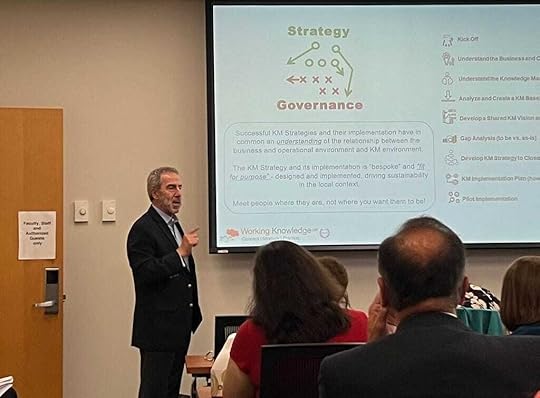 Bill Kaplan presenting at the 2023 Midwest KM Symposium
Bill Kaplan presenting at the 2023 Midwest KM Symposium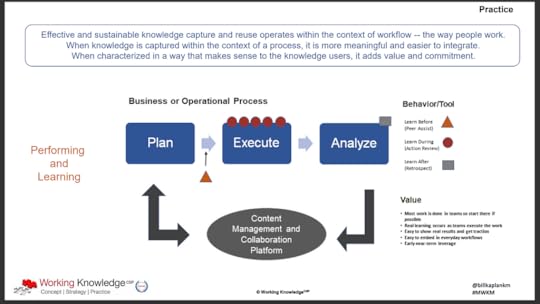 Performing and Learning
Performing and Learning Operationalizing Learning
Operationalizing Learning Context puts a face on knowledge and lets you see inside
Context puts a face on knowledge and lets you see inside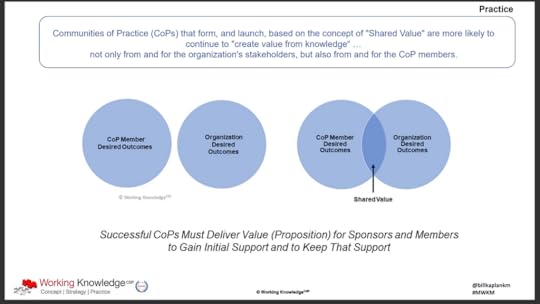 Successful Communities of PracticePodcastsKM Journey, KM Philosophy, the ISO Standard, and the Value of a KM Strategy — Santosh ShekarBecause You Need To Know — Edwin K. MorrisKnowledge Cast — Zach WahlKnowledge Cast — Making Knowledge Management Clickable — Bill interviews Zach Wahl and Joe Hilger of Enterprise KnowledgeVideosGlobal Knowledge Management Congress & Awards 2016https://medium.com/media/c88b393b0ec9af2f026bf8b933960574/hrefStriking a Balance Between KM Theory, Concepts and Practical Applicationhttps://medium.com/media/f9b8d39d1fb612021c53cfc0419fe833/hrefCommunity of Practice Success and the Concept of Shared Valuehttps://medium.com/media/cd1882258fd0c9174d66a45ca1e96eb8/hrefDifference between Knowledge Management and Knowledge Leadershiphttps://medium.com/media/d41367bf325ef92913843c605d236a42/hrefCharacteristics of Knowledge-Enabled High-Performing Organizationshttps://medium.com/media/50e7c427d006b95b3a5b2da317340b2c/hrefAgile Knowledge Managementhttps://medium.com/media/c7718183d2bb851148a1eeba59f33199/hrefHow Training Can Help Manage Organizational Knowledgehttps://medium.com/media/7f6e2947b9fc1cd8ca3479c680aa9f7b/hrefResolving the Issue of Workforce Turnover and Knowledge Losshttps://medium.com/media/fd7171108a46d6cbb0d439103705d508/hrefCompetencies of a Chief Knowledge Officerhttps://medium.com/media/7fe21a4b8365b262fe53407dd9d535d7/hrefMeasuring the Intangible Elements of Knowledgehttps://medium.com/media/b09ed082502631340c3b79583957d12e/hrefComparing KM in the private sector and in global developmenthttps://medium.com/media/4f66590019f07efc5530f3a9b3c18073/hrefStrategies for gaining a competitive edge through employee engagement and satisfactionhttps://medium.com/media/2166096bfe6344803c3e9939692a973f/hrefBooksLosing your minds: Capturing, Retaining and Leveraging Organizational KnowledgeTable of Contents, Summary, and ForewordReview by Mimi Dionne
Successful Communities of PracticePodcastsKM Journey, KM Philosophy, the ISO Standard, and the Value of a KM Strategy — Santosh ShekarBecause You Need To Know — Edwin K. MorrisKnowledge Cast — Zach WahlKnowledge Cast — Making Knowledge Management Clickable — Bill interviews Zach Wahl and Joe Hilger of Enterprise KnowledgeVideosGlobal Knowledge Management Congress & Awards 2016https://medium.com/media/c88b393b0ec9af2f026bf8b933960574/hrefStriking a Balance Between KM Theory, Concepts and Practical Applicationhttps://medium.com/media/f9b8d39d1fb612021c53cfc0419fe833/hrefCommunity of Practice Success and the Concept of Shared Valuehttps://medium.com/media/cd1882258fd0c9174d66a45ca1e96eb8/hrefDifference between Knowledge Management and Knowledge Leadershiphttps://medium.com/media/d41367bf325ef92913843c605d236a42/hrefCharacteristics of Knowledge-Enabled High-Performing Organizationshttps://medium.com/media/50e7c427d006b95b3a5b2da317340b2c/hrefAgile Knowledge Managementhttps://medium.com/media/c7718183d2bb851148a1eeba59f33199/hrefHow Training Can Help Manage Organizational Knowledgehttps://medium.com/media/7f6e2947b9fc1cd8ca3479c680aa9f7b/hrefResolving the Issue of Workforce Turnover and Knowledge Losshttps://medium.com/media/fd7171108a46d6cbb0d439103705d508/hrefCompetencies of a Chief Knowledge Officerhttps://medium.com/media/7fe21a4b8365b262fe53407dd9d535d7/hrefMeasuring the Intangible Elements of Knowledgehttps://medium.com/media/b09ed082502631340c3b79583957d12e/hrefComparing KM in the private sector and in global developmenthttps://medium.com/media/4f66590019f07efc5530f3a9b3c18073/hrefStrategies for gaining a competitive edge through employee engagement and satisfactionhttps://medium.com/media/2166096bfe6344803c3e9939692a973f/hrefBooksLosing your minds: Capturing, Retaining and Leveraging Organizational KnowledgeTable of Contents, Summary, and ForewordReview by Mimi Dionne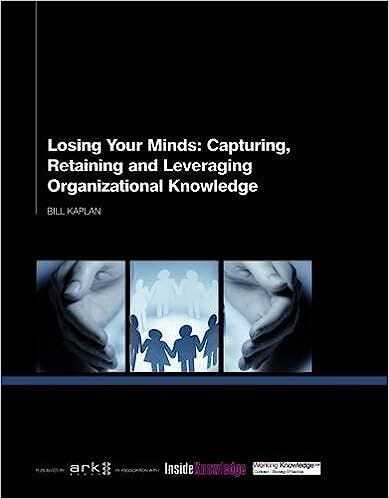 Gaining buy-in for KM edited by Laura SlaterChapter 3: Knowledge accountability drives knowledge management success
Gaining buy-in for KM edited by Laura SlaterChapter 3: Knowledge accountability drives knowledge management success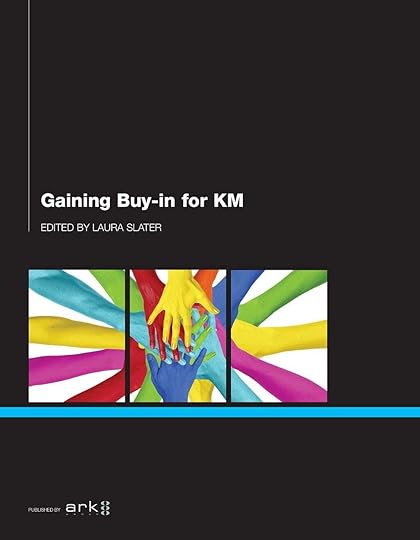 [image error]
[image error]
July 7, 2023
9th Annual Midwest KM Symposium, Part 2: Zach Wahl

This is the second in a series of posts about the Midwest Knowledge Management Symposium held June 16, 2023 at Kent State University in Kent, Ohio. This post is about the afternoon keynote delivered by Zach Wahl, CEO of Enterprise Knowledge, one of the three sponsors of the event.
Making Knowledge Management Clickable: Ensuring KM is Recognized as a Business Critical Element of Your Organization presented by Zach Wahl, Co-Author of Making Knowledge Management Clickable
Zach has over 20 years of experience leading programs in the knowledge and information management space. He has worked with more than 200 public and private organizations to successfully strategize, design, and implement information management systems, including knowledge bases, intranets, content management, document management, taxonomy management, and websites (eCommerce and informational). Zach has developed his own taxonomy design methodology, has authored a series of courses on knowledge management, and is a frequent speaker and trainer on information governance, web strategy, and taxonomy design.
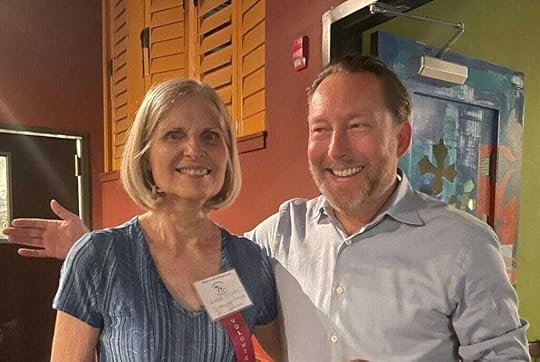 Midwest KM Symposium Co-Chair Linda Hummel with Sponsor and Keynote Speaker Zach Wahl
Midwest KM Symposium Co-Chair Linda Hummel with Sponsor and Keynote Speaker Zach WahlZach presented a talk based on his book of the same title and the work that his consulting firm, Enterprise Knowledge, performs for clients. He started with two definitions:
Knowledge management involves the people, culture, processes, and enabling technologies necessary to capture, manage, share, and find information.The new mission of KM is to link all of an organization’s knowledge, in all its forms, making it not just findable, but understandable and actionable.He further deconstructed KM into five segments:
1. People
Flow of knowledge through the organization.Knowledge holders and knowledge consumers.Understanding of state and disposition of experts.2. Process
Existence and consistency of processes.Awareness of and adherence to processes.Quality of processes.3. Content
State and location of content.Consistency of structure and architecture.Dynamism of content. Understanding of usage (analytics).4. Culture
Senior support and comprehension.Willingness to share, collaborate, and support.5. Technology
Maturity of KM Suite.Integration with and between systems.Usability and user-centricity.Zach recommended focusing on high-value moments of knowledge capture and triggering experts to share at those times. He showed a KM Action Wheel with these spokes:
Create: The point at which knowledge or information is first exposed, either in written or verbal form.Capture: The collection of information in a tool or repository (from tacit to explicit) so that it can be managed.Manage: Tools, technologies, and processes required to secure, organize, control, and expose the right information to the right people.Enhance: Processes to evolve and prime the information.Find: Tools and technologies to help people find the content they need, when they need it.Connect: Creating links between knowledge and information, between the holders of knowledge (experts), and between repositories.He encouraged confronting six KM challenges being faced today:
Proliferation of knowledge and information systems.Less structure, more social.Remote and hybrid work.Exponential increases in content and data.More barriers to collaboration and connections.The great resignation.Zach said that artificial intelligence can be made real if you lay the right KM foundation:
Governance: The roles, responsibilities, processes, and procedures necessary to maintain KM-related processes over time.Taxonomy & Information Architecture: Taxonomies are controlled vocabularies used to describe explicit concepts. Information architecture standardizes and simplifies where and how content is stored and tagged.Content/Document Management: The strategies, methods, and tools used to capture, manage, store, and share content and documents in the most optimal way possible.Search: The best search experiences connect people to information, information to information, and people to people, while addressing foundational concepts in search.Collaboration: The ability for stakeholders and users to work together in terms of content creation and content management.Change Management: Places people at the center of the process to make change real and ensure it sticks.Automation: The ability to reduce the manual work associated with tasks, processes, and procedures through the creation and application of technology.He showed the following chart differentiating capture techniques from no tech to high-tech (X axis) and from one-to-one to many-to-many (Y axis):
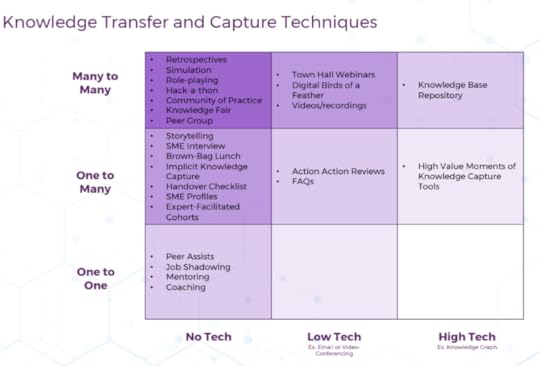
Zach then defined ten core KM technologies and listed example software for each:
1. Web content Management: Used to author, organize, manage, and publish content on a website. Examples:
SiteCoreGraphCMSCloudCMSDrupalWordPressContentful2. Document & Records Management: Designed to manage, secure, and control documents across an enterprise. Examples:
AlfrescoDocumentumBox.comOpenTextGoFileRoomMicrosoft 365 / SharePoint3. Digital Assets Management: Designed to manage digital products like videos and images. Most frequently used by marketing and publishing departments. Examples:
Adobe Experience Manager AssetsBynderIconik4. Business Content Management: Content management tools built for a specific business purpose like customer or contract management. Examples:
Apttus Contract ManagementSalesForceDynamics 365Learning Management5. Collaboration: Tools designed to enable users to share content and collaborate using instant messaging or video conferencing. Examples:
Microsoft 365 / TeamsSlackShareFileFirmex6. Knowledge Graphs: Architecture and data models to enable machine learning (ML) and other AI capabilities. Drive efficient and intelligent data and information management solutions. Examples:
Expert FinderRecommendation EngineCustomer 3607. Taxonomy Management: Enables organizations to maintain and expose their business taxonomies to KM systems. Examples:
PoolParty (SWC)Cambridge SemanticsSemaphore (SmartLogic)Synaptica8. Ontology Management: Empowers the creation and management of complex relationships between various sources of data. Examples:
StardogNeo4jNeptuneOntotext9. Enterprise Search: Search tools designed to query across multiple KM systems. Examples:
SinequaLucidworks FusionElasticsearchSolr10. Component Content Management: Manages content at a granular level so portions of a piece of content can be reassembled and used for other content. Examples:
MarklogicEasyDITASDL TridionHe finished the presentation by discussing Knowledge Graphs, Content Assembly and Customization, and Knowledge Portals and Advanced Search. Zach made efficient use of the 30 minutes allotted for his keynote. He offered useful frameworks and practical advice based on extensive experience delivering KM consulting to clients. You can read his blog posts and listen to his Knowledge Cast podcasts.
Part 3 of this series will feature Valdis Krebs. Part 1 featured Tom Stewart.
[image error]June 30, 2023
9th Annual Midwest KM Symposium, Part 1: Tom Stewart
Originally posted 29-Jun-23

The Midwest Knowledge Management Symposium was held on June 16, 2023 at Kent State University in Kent, Ohio. It was the first time the event was held since 2020, and the first time it was held in person since 2019.
The goals of the symposium are to provide an opportunity for anyone who wants to speak to do so, to allow those in the midwestern U.S. to attend a significant event within driving distance, and to provide a high-value conference with an affordable registration fee.
This year’s co-chairs were Linda Hummel, Strategy Knowledge Manager, EY Parthenon and Kendra Albright, Goodyear Endowed Professor of Knowledge Management, School of Information, College of Communications and Information, Kent State University. The event sponsors were Lucidea, Enterprise Knowledge, and Bloomfire.
The first Midwest KM Symposium was held in Detroit in 2008. The next two were held in Chicago in 2009 and 2010. Cleveland was the location in 2011, 2017, and 2018. The last in-person event was in Cincinnati in 2019, and there was a virtual symposium in 2020.
2023 Program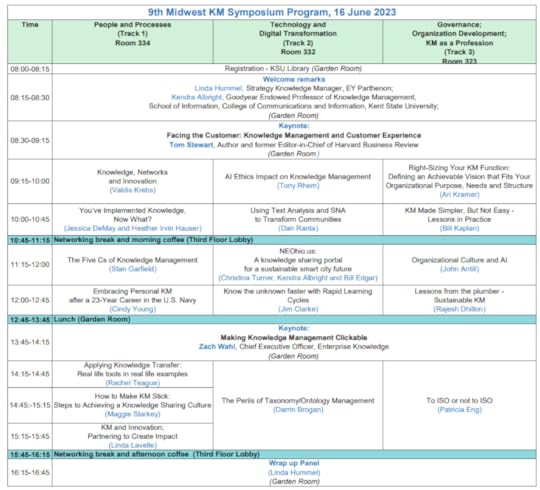
I presented “The Five Cs of Knowledge Management” and attended eight other presentations:
Morning Keynote: “Facing the Customer: The Customer’s Knowledge Journey — Knowledge Management and Customer Experience” by Tom Stewart“Knowledge Serendipity: Networks, Conversations, and Interactions” by Valdis Krebs“Using Text Analysis and SNA to Transform Communities” by Dan Ranta“Lessons from the Plumber: Sustainable KM” by Rajesh DhillonAfternoon Keynote: “Making Knowledge Management Clickable” by Zach Wahl“Applying Knowledge Transfer: Real Life tools in Real Life Examples” by Rachel Teague“How to Make KM Stick: Steps to Achieving a Knowledge Sharing Culture” by Maggie Starkey“KM and Innovation: Partnering to Create Impact” by Linda LavelleStarting this week, I will blog about each of these eight sessions. This post is about the morning keynote delivered by Tom Stewart.
Facing the Customer: The Customer’s Knowledge Journey — KM and Customer Experience Thomas A. Stewart , author of Intellectual Capital and The Wealth of Knowledge; co-author of Woo, Wow, and Win; and former Editor-in-Chief of Harvard Business Review
Tom started by asking the question, “How does knowledge management relate to customer delight?” He proceeded to answer this question, drawing on his experience in writing about KM and service design.
KM has focused on knowledge that resides in the organization.
Human capital: Who knows what, what knowledge is needed for a task or role, knowledge sharing, internal communities of practiceStructural capital: Documentation of processes, analysis and curation of IP, data, and information, best practices, “single version of the truth”Customer capital: brand, digital asset management, CRM, “single view of the customer”Knowledge is a critical part of a customer’s journey.
What does the customer know or need to know to make a decision?What knowledge do we need to serve the customer?From whom and where does the customer get knowledge?How do we move internal knowledge from one touchpoint to another without reentering data?Tom discussed six customer experience knowledge problems.
Knowledge Problem #1: Choice. There are too many choices, so make it easier to choose.Knowledge Problem #2: How Do I? Make products and services simpler.Knowledge Problem #3: Service. Make it easy to do business with you.Knowledge Problem #4: Coherence. Customers should have a single view of the company and its partners, independent of the channel or platform used.Knowledge Problem #5: Customer Perceived Value. “People don’t want to buy a quarter-inch drill. They want a quarter-inch hole!”Knowledge Problem #6: Customer Success. Help your customers become power users.He suggested creating a privileged insights system to hold proprietary customer knowledge.

Tom asked what bi-directional KM would look like, and proposed an approach where knowledge flows between the company and its customers in both directions.
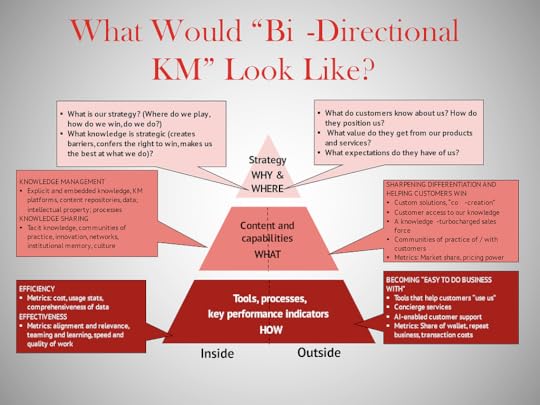
Tom then offered eight initiatives to apply KM to strengthen customer experience and create customer capital.
Identify customers’ knowledge needs at key touchpoints. What must they know to make decisions, get the most value?Identify internal knowledge needs at key touchpoints. What must you know to “win” this touchpoint?Share knowledge horizontally, vertically, with partner companies, and with customers.Integrate KM and CRM: knowledge for customers and knowledge about them.Forge continuous learning loops among customers, your front line, and the back office.Use KM tools to help customers use your products and services better.Develop knowledge-based ways to increase customers’ value to you and yours to them — e.g., co-creation.Create knowledge repositories and communities of practice for and with customers.Tom concluded his talk by providing three sets of three questions that should be asked.
The knowledge strategist’s fundamental questions:
What knowledge sets us apart from our competitors?How should we create, renew, or extend our knowledge?What is our knowledge worth?The knowledge manager’s fundamental questions:
How can we capture what we learn?How can we distribute knowledge to people who need it?How can we get more out of the knowledge we have?The experience designer’s fundamental questions:
What experience do we want our customer to have?What does our customer see at each stage of his or her journey?What must happen backstage to make the magic happen every time?Tom Stewart’s presentation was engaging, humorous, and insightful. Combining knowledge management and customer experience design is an important step for making KM valuable within organizations. For more about Tom Stewart and his writing, see my Profile in Knowledge.
[image error]June 25, 2023
Profiles in Knowledge: Göran Roos and Johan Roos

This is the 92nd article in the Profiles in Knowledge series featuring thought leaders in knowledge management. Göran and Johan Roos are brothers, originally from Sweden, who now live in England. They were co-founders of Intellectual Capital Services Ltd. (ICS), a London-based strategy consulting firm and think tank in the fields of innovation management, value measurement, strategy and management of intellectual capital, and strategic learning experiences.
Göran and Johan are pioneers of the intellectual capital movement along with Karl-Erik Sveiby, Leif Edvinsson, Thomas Stewart, and Nick Bontis. When I was writing profiles on Leif, Nick, and Georg von Krogh, I noticed that the names “G. Roos” and “J. Roos” appeared several times as co-authors. I wondered if they were related, so I asked ChatGPT. Here is the response I received:
Both Johan Roos and Göran Roos are recognized as experts in the field of intellectual capital. While they share the same last name, there is no widely available information to suggest that they are related to each other.
Johan Roos is a Swedish academic and researcher known for his work on the concept of intellectual capital and the development of the “Intellectual Capital Navigator.” He has made significant contributions to the field of management and has held various academic positions, including professorships at institutions like IMD Business School and Halmstad University.
Göran Roos, also from Sweden, is a renowned economist and management consultant specializing in the areas of innovation, technology, and intellectual capital. He has worked extensively with both private and public organizations, advising them on strategic management and innovation practices. Göran Roos is widely recognized for his expertise in the field of intellectual capital and has published several influential works on the subject.
While both individuals have contributed significantly to the field of intellectual capital, there is no readily available information suggesting a familial relationship between them.
Then I asked Bard and it provided this reply:
Johan and Göran Roos are not related by blood, but they are related by their work on intellectual capital. They are both Swedish organizational theorists and have co-authored several books and articles on the topic. In 1998, they co-authored the book Intellectual Capital: Navigating in the New Business Landscape, which is considered to be a seminal work on the topic.
Johan Roos is currently the Chief Strategy Officer at Hult International Business School. Göran Roos is the Chairman of Intellectual Capital Services (ICS). They have both made significant contributions to the field of intellectual capital and their work has helped to raise awareness of the importance of this intangible asset.
But a Google search returned two results stating they are brothers:
Valuing Knowledge: Is It Worth It? by David Skyrme: “The IC-IndexTM, developed by the Roos brothers and colleagues and now marketed by Intellectual Capital Services. Its unique characteristic is that it focuses on the change and flows of intellectual capital, even where it is difficult to ascribe absolute value.”The Human Value of the Enterprise: Valuing People as Assets — Monitoring, Measuring, Managing by Andrew Mayo: “Göran and Johan Roos are brothers.”I then decided to try asking each of them directly through LinkedIn messages:
Johan
Me: Johan, I am writing a profile in knowledge about you. I wonder if you are related to Göran Roos?Johan S Roos: BrotherGöran
Me: Göran, are you and Johan brothers?Göran Roos: yesThe lesson learned: Generative chat tools can be helpful but are not a substitute for actual human interaction and going directly to the source whenever possible.
Göran Roos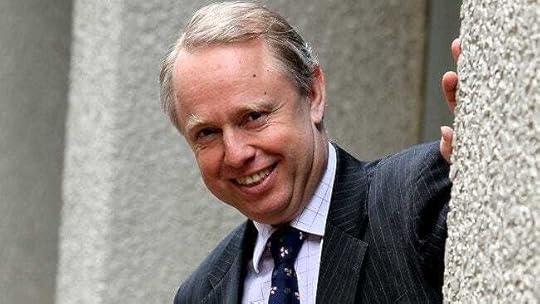
Göran Roos is Chairman of the Board of The NeuroTech Institute in Adelaide, Australia. He is the Managing Director of Intellectual Capital Services Ltd, a technology and business futures think tank. Göran is based in Addington, England. His full name is Nils Göran Arne Roos.
He is Visiting Professor in Business Performance and Intangible Asset Management, Centre for Business Performance, Cranfield School of Management, Cranfield University and Visiting Professor at Australian Industrial Transformation Institute, Flinders University. Göran is a CSIRO fellow and a fellow of the Australian Academy of Technological Sciences and Engineering (ATSE) and of the Royal Swedish Academy of Engineering Sciences (IVA).
Göran has also held academic appointments at Nanyang Technological University; University of Adelaide; University of Technology Sydney; Swinburne University of Technology; Warwick University; University of South Australia; Melbourne Business School, Mt. Eliza Centre for Executive Education, Immanuel Kant Baltic Federal University and BI Norwegian Business School.
He is the author and co-author of over three hundred books, book chapters, papers and articles on Intellectual Capital, Innovation Management, Strategy and Industrial Policy, many of which have been recognized with awards. He has around 14,000 Google Scholar citations.
Göran has worked as a consultant in more than 50 countries and is one of the founders of modern intellectual capital science and a recognized world expert in this field as well as a major contributor to the thinking and practice in the areas of strategy and innovation management as well as industrial and innovation policy.
He is a member of these editorial boards:
Knowledge Management Research & Practice (KMRP)Electronic Journal of Knowledge Management (eJKM)International Journal of Strategic Change ManagementInternational Journal of Learning and Intellectual CapitalJournal of Intellectual CapitalHis specialties include strategy; innovation management; and industrial, innovation and research policy.
BackgroundEducationUniversity of South Australia — Doctor of Philosophy — PhD, StrategyHenley Business School — Advanced Postgraduate Diploma in Management Consultancy, 1998INSEAD — Master of Business Administration — MBA, 1988–1989Chalmers University of Technology — Master’s degree, Engineering Physics, 1977–1982ExperienceThe NeuroTech Institute, Adelaide, Australia — Chairman of the Board, 2018 — PresentIntellectual Capital Services (ICS) Ltd. — Co-Founder, 1995 — presentUniversity of Technology Sydney — Adjunct Professor, 2014–2018Advanced Manufacturing Council, Adelaide, Australia — Chairperson, 2012–2014VTT International — Chairman of the Board, 2010–2012Roos, von Krogh & Partners — Managing Director, 1995–1998ProfilesLinkedIn: AdvisorLinkedIn: ProfessorWikipediaIdeas on DesignThe ConversationContentPublicationsResearchGateGoogle ScholarSemantic ScholarAcademia.eduTypesetOrcidICS ResearchIntellectual capital and knowledge management effectiveness with Bernard Marr, Oliver Gupta, and Stephen PikeEvaluating Intellectual Capital and measuring knowledge management effectiveness with Oliver Gupta and Stephen PikeMeasuring the impact of knowledge management in companies with Stephen PikeKnowledge creation through national innovation systems with Lisa Boldt-Christmas and Stephen PikeKnowledge management, intellectual capital, structural holes, economic complexity and national prosperityThe Knowledge Toolbox: A review of the tools available to measure and manage intangible resources with Nick Bontis, Nicola Dragonetti, and Kristine Jacobsen Figure 1: The value distinction treeArticles by Others
Figure 1: The value distinction treeArticles by OthersA conversation by Jay Chatzkel
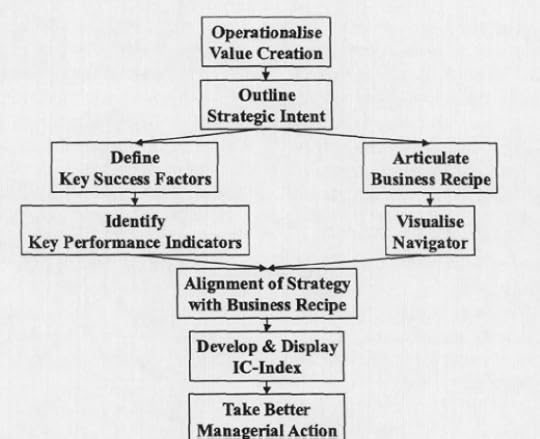 Figure 1: An Outline of the IC Process
Figure 1: An Outline of the IC ProcessHenley: Open Innovation & Werewolves by Dave Snowden
Göran Roos now, intending to be controversial by challenging open innovation. Three types: outside-in (integrating external sources) Insider-out (bringing ideas to market) & coupled (both).
Outside-In — tend to be low tech, highly modular, high knowledge intensity and act as knowledge brokers and/or creatorsInside-out — tend to be research driven, multiply technology etc. (flipping through slides too quickly for me to absorb I am afraid but I suspect he is summarising a paper so you can probably find it)Sources of external knowledge — suppliers and customers are the highest, Universities and Research Institutes are the lowest! Suggests this is because of discontinuities between timelines. Low technology customers get the highest return from understanding customers. High Tech, on the other hand, start to get returns by having many shallow relationships with many Universities but that takes resource (claims this from research). Generally better to go broader rather than deeper.
Open innovation means added costs and the external sources do not share the same context with cost implications. Engagement in open systems starts high, but then declines due to motivational and other issues. Tradeoff issues for provider do not match context of requester. No written contracts, what is foreground and background IP? Which legal system etc. etc. Some people are malicious (Victor is starting to look like an optimist in comparison!)
Why does it not pay? number of sources to be handled past three gets negative, past six you can’t handle it. Therefore limited by definition. Good point here, but there are better ways to handle that, will pick up in my presentation later (fragmentation, multi-source assessment, fitness landscapes)
Moved on to what should we do. Early stages of life cycle, then use a small number of key sources intensively. As the market matures etc then more and more actors have specialized knowledge, So you need to scan a wider number of search channels. Good advice, they are no silver bullets . Open innovation can not be a substitute for internal innovation.
Most useful item of knowledge — there is a supplier of silver bullets in the USA who will warrant their effectiveness against werewolves. Do a Google search on “silver bullet suppliers” to be really scared.
PodcastsThe significance of intellectual capitalBusiness Strategies Capturing Opportunities in Disruptive TimesVideosYouTubeBooksManaging Intellectual Capital in Practice with Stephen Pike and Lisa Boldt-Christmas
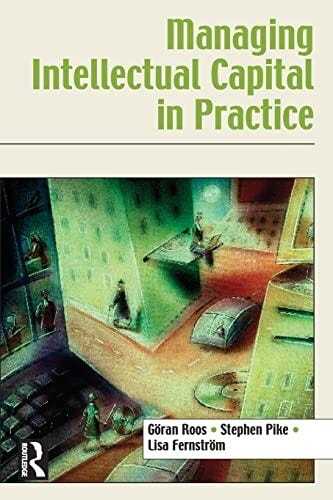
Intellectual Capital Management: A Strategic Perspective edited with Sharath Jutur
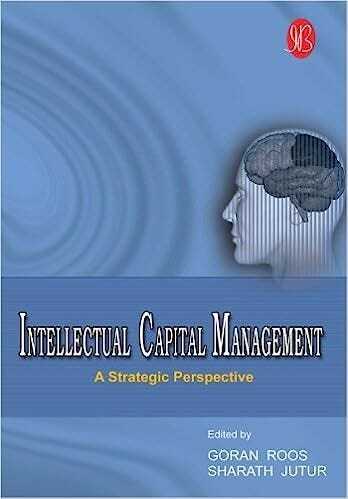
Intellectual Capital as a Management Tool. Essentials for Leaders and Managers with Stephen Pike
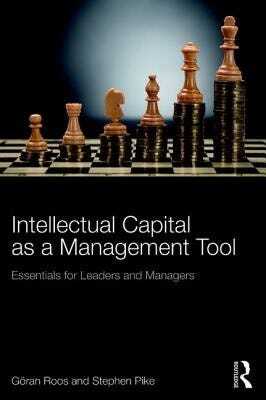
Knowledge Capital: How Knowledge-Based Enterprises Really Get Built by Jay Chatzkel — Chapter 5. Recipes for Knowledge-Based Value Creation
Johan Roos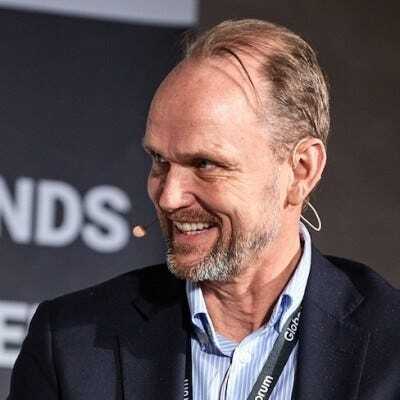
Johan Roos is a Swedish organizational theorist, and Chief Academic Officer at Hult International Business School, known for his work on intellectual capital, co-invention of LEGO Serious Play™, and extensive writing on strategy and innovation. He is based in London, England.
His mission is driving academic excellence in a unique business school while contributing to the public debate about its global ecosystem. He is also an early investor in start-ups.
Johan’s research has focused on strategic and leadership processes in alliance formation, knowledge management, and strategy. He is the author or co-author of many articles, book chapters, and books as well as case studies, papers, and articles for practitioners. He has published in many prestigious journals, is a regular contributor to international academic conferences, and he serves as a peer reviewer for premier scholarly journals.
His specialties include intellectual capital, management innovation, Peter Drucker’s work, serious play, the human economy, and generative AI.
BackgroundEducationStockholm School of Economics — Doctor of Philosophy (PhD), International Business, 1986–1989Swedish University of Agricultural Sciences (SLU) — Master of Science (MSc), Agriculture (Economics and Management), 1981–1985ExperienceHult International Business School, London — Chief Academic Officer & Professor, 2016 — PresentPeter Drucker Society Europe, Austria — Senior Advisor, 2022 — PresentCo-inventor of LEGO Serious Play, 1998 — PresentImagination Lab Foundation, Lausanne, Switzerland — Co-founder, 2000 — PresentOn the Agenda ApS, Copenhagen — Co-Founder, 2014–2019 (Consulting service founded on the guiding principles summarized in the book Bridging the Gender Gap)Jönköping International Business School (JiBS), Jönköping, Sweden — Dean, Managing Director & Professor, 2012–2015Copenhagen Business School — President, 2009–2011Stockholm School of Economics — Dean of MBA Programs & Bo Rydin and SCA Professor of Strategy, 2007–2009Executive Discovery LLC — Co-Founder, 1998–2003IMD Business School, Lausanne, Switzerland — Professor of General Management and Strategy, 1995–2000Intellectual Capital Services (ICS) Ltd. — Co-Founder, 1995–1999 (Consulting company specializing in measuring intellectual capital in corporations)BI Norwegian Business School, Oslo — Associate Professor of Strategy, 1990–1994 (includes Research Fellow position at the Norwegian Institute for Marketing, a non-profit research foundation affiliated with BI, pioneering customer satisfaction research and tools in collaboration with University of Michigan)The Wharton School — Research Associate, William H. Wurster Center for Multinational Management, 1988–1990ProfilesLinkedInWikipediaContentHultLinkedIn ArticlesLinkedIn PostsLinkedIn DocumentsPublicationsResearchGateGoogle ScholarSemantic ScholarStockholm School of EconomicsGlobal Peter Drucker Forum BlogOrcidResearch.comAn Essay on Corporate Epistemology with Georg von Krogh and Ken SlocumStriking a Balance: Complexity and Knowledge Landscapes with David OliverDriving Organizational Readiness for Change through Strategic Workshops with Viktor NilssonA perspective on knowledge, competence and strategy with Georg von KroghFuture Research into Knowledge Management with Markus Venzin and Georg von KroghPodcastUnlocking Innovation with the Power of PlayVideoshttps://medium.com/media/ce1b96abc31d4ba0fab419f575b612f3/hrefhttps://medium.com/media/87048430f5c5b8f159ffcf6e7169fc37/hrefEvents That Changed Management Education
https://medium.com/media/d67509f5e03bf46d15e9d58d704c6532/hrefBusiness Education Is ‘Glocal’
https://medium.com/media/1744e07edb43fd6420fa71b5a70f71fa/hrefBooksDisrupting Innovation Through Collaborative Competitions: Extreme Breakthroughs Solving Any Challenge Faster Better Smarter with Sigvald Harryson
Blog post and sample chapter
Organizational Epistemology with Georg von Krogh

Striking a Balance in Complexity and Knowledge Landscapes with David Oliver

Bridging the Gender Gap: Seven Principles for Achieving Gender Balance with Lynn Roseberry

The Next Common Sense: Mastering Corporate Complexity Through Coherence with Michael Lissack
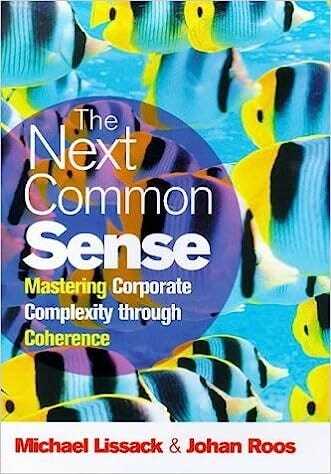
Innovating Strategy Processes edited with by Steven Floyd, Claus Jacobs, and Franz Kellermanns
Knowing in Firms: Understanding, Managing and Measuring Knowledge edited with Georg von Krogh and Dirk Kleine
Managing Knowledge: Perspectives on Cooperation and Competition edited with Georg von Krogh
Implementing Strategic Processes: Change, Learning and Cooperation edited with Peter Lorange, Bala Chakravarty, and Andrew Van de Ven
ExcerptGöran and Johan: Joint PublicationsArticlesValuing intellectual capital — Financial Times, Mastering Management JournalA 2nd Generation of Intellectual Capital Practices — Financial Times, Mastering Management JournalIntellectual performance: exploring an intellectual capital system in small companies — Knowledge in Action ConferenceMeasuring Your Company’s Intellectual Performance
 Figure 3: Limited distinctions of intellectual capital
Figure 3: Limited distinctions of intellectual capital Figure 4: Five main categories of intellectual capitalBooks
Figure 4: Five main categories of intellectual capitalBooksStrategi: en innføring (Strategy: an introduction), 7th edition with Georg von Krogh
Intellectual Capital: Navigating in the New Business Landscape with Nicola Carlo Dragonetti and Leif Edvinsson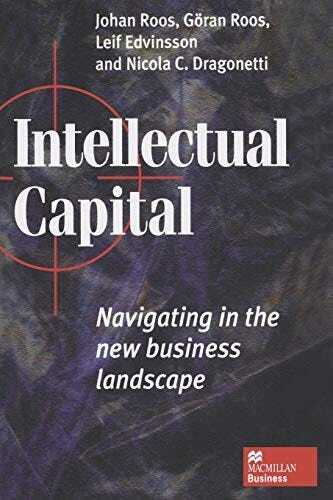 Article about this book
Article about this bookThe Human Value of the Enterprise: Valuing People as Assets — Monitoring, Measuring, Managing by Andrew Mayo
Göran and Johan Roos are brothers, one a consultant and the other a professor at IMD in Lausanne. They have worked extensively in advising companies on intellectual capital management and developed a measuring tool called the IC-index. They distinguish between different generations of intellectual capital thinking:
First generation: concerned with awareness, identifying indicators and developing some kind of reportSecond generation: concerned with a focus on changes and flows between different kinds of intellectual capital; develops indices and compares them with market value.Roos, Roos, Edvinsson, and Dragonetti divide human capital as follows:
Competence. These authors define competence as being essentially about knowledge and skills, and by knowledge they mean specifically the “technical or academic knowledge of things,” related to education, something that “has to be taught.” Skills they see as its practical counterpart. This approach is reflected in many of the measures used by the pioneering Scandinavian companies.Attitude. This, say Roos et al., depends mostly on personality traits and can be changed very little. It is influenced by “motivation, behavior and conduct.” The Human Capital Monitor argues that these are strongly dependent on the environment in which people work.Intellectual agility. This is used to cover innovation, flexibility, and adaptability — traits seen at a group or organizational level as much as in individuals.IC-Index
We referred earlier to Johan and Göran Roos and their first and second generations of intellectual capital. They concluded that because it was so difficult to measure intellectual capital itself, the focus should be on measuring changes. To this end they developed a tool called the IC-Index.
Their distinguishing concept is that it is the flows between components of intellectual capital and financial capital that matter. As they put it: “Balance sheets are still photographs. What drives an organization is the movie — each frame different from its predecessor. It’s a dynamic where different kinds of capital growth feed into each other.” What they call second-generation IC, as opposed to the more simplistic formula of the first generation, is about carefully selected measures and the interaction between them. Roos and Roos recognize that financial and intellectual capital must be balanced — one is consumed to maintain the other.
They therefore break down the overall intellectual capital into subsections, using the categories of human, customers and relationships, processes and infrastructure, and renewal and innovation. For each category a small set of indicators is carefully chosen. These indicators are each weighted to form a category index, and the category indices are themselves weighted to form an overall IC-Index.
This approach is customized based on an organization’s specific strategies, and the factors that will make or break each key strategy. Indicators that will track these factors are then grouped in the four categories to make the indices.
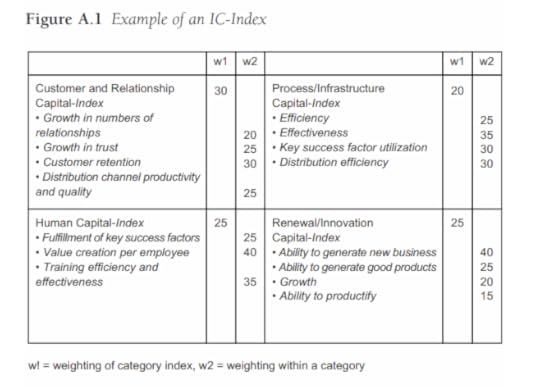 Figure A.1 Example of an IC-Index[image error]
Figure A.1 Example of an IC-Index[image error]
June 23, 2023
Knowledge Management Thought Leader 37: Jessica Lipnack

Jessica Lipnack is an author, speaker, and editor who has written extensively about virtual teams. She was an external consultant to Digital Equipment Corporation from 1984 to 1992. Jessica was the CEO and co-founder of NetAge from 1998 to 2015, where she and her husband Jeffrey Stamps (1944–2011) provided expertise on networks and collaboration. They wrote the books Networking, The Age of the Network, and Virtual Teams. She has consulted on collaboration and networks around the world. Jessica maintained the blog, Endless Knots, for 10 years.
EducationAntioch College — BA, Philosophy, Literature, 1965–1970ExperienceAuthor, Speaker, Editor — 1970 — PresentCo-chair, Board of Directors — Buckminster Fuller Institute, 2016–2018CEO, Co-founder — NetAge, 1998–2015Profiles NetAge LinkedIn Twitter Facebook Cutter Consortium Buckminster Fuller Institute IBS Case Development Centre Profiles in Knowledge BooksVirtual Teams: People Working Across Boundaries with Technology with Jeffrey Stamps — Download
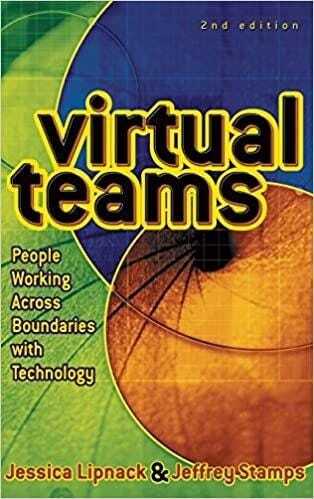
The Age of the Network: Organizing Principles for the 21st Century with Jeffrey Stamps — Download

The Networking Book: People Connecting with People with Jeffrey Stamps — Download

The TeamNet Factor: Bringing the Power of Boundary Crossing into the Heart of Your business with Jeffrey Stamps — Download

Networking, the First Report and Directory with Jeffrey Stamps
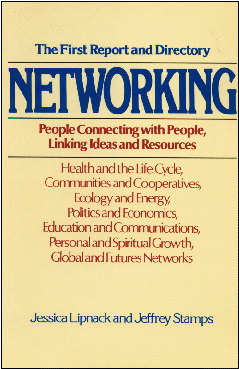 Book ChaptersAdvances in Appreciative Inquiry, Volume 1:
Constructive Discourse and Human Organization
edited by David Cooperrider and Michel Avital — Chapter 2:
Appreciative Inquiry in the Age of the Network
with Jeffrey Stamps
The Handbook of High Performance Virtual Teams: A Toolkit for Collaborating Across Boundaries
edited by Jill Nemiro, Michael Beyerlein, Lori Bradley, and Susan Beyerlein — Chapter 30:
The Virtual, Networked Organization: How One Company Became Transparent
with Jeffrey StampsInterviews
The importance of virtual teams during COVID-19
by Laurence Lock Lee
Working through Working from Home
by
Tom Stewart
Presentations
Are Organizations Networks?
with Jeffrey Stamps
Virtual Teams 2.0, 3.0, 4…
with Jeffrey Stamps
Earth-OrgScope: Applying a Science of Organization Networks
with Jeffrey Stamps
Leading Virtual Teams: Managing People at a Distance
with Terry Seamon
The Transformational Power of Networks, Teamnets, and Virtual Teams
with Jeffrey StampsDeveloping Networked Teams of Leaders for the High-Performance Learning Organization with Mike Prevou and Jeffrey Stamps
Book ChaptersAdvances in Appreciative Inquiry, Volume 1:
Constructive Discourse and Human Organization
edited by David Cooperrider and Michel Avital — Chapter 2:
Appreciative Inquiry in the Age of the Network
with Jeffrey Stamps
The Handbook of High Performance Virtual Teams: A Toolkit for Collaborating Across Boundaries
edited by Jill Nemiro, Michael Beyerlein, Lori Bradley, and Susan Beyerlein — Chapter 30:
The Virtual, Networked Organization: How One Company Became Transparent
with Jeffrey StampsInterviews
The importance of virtual teams during COVID-19
by Laurence Lock Lee
Working through Working from Home
by
Tom Stewart
Presentations
Are Organizations Networks?
with Jeffrey Stamps
Virtual Teams 2.0, 3.0, 4…
with Jeffrey Stamps
Earth-OrgScope: Applying a Science of Organization Networks
with Jeffrey Stamps
Leading Virtual Teams: Managing People at a Distance
with Terry Seamon
The Transformational Power of Networks, Teamnets, and Virtual Teams
with Jeffrey StampsDeveloping Networked Teams of Leaders for the High-Performance Learning Organization with Mike Prevou and Jeffrey StampsThis slide is from 2008:
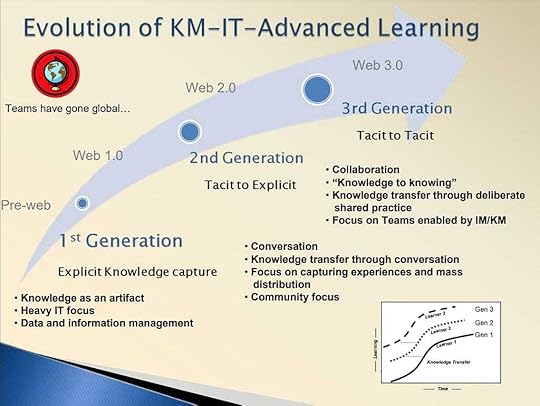 NetAge Site
NetAge Site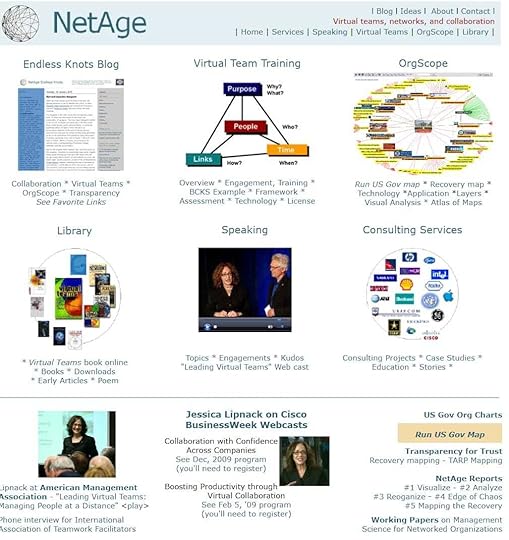 Posts
LinkedIn
Endless Knots Blog
Medium
Articles
Early Articles
NetAge Reports
Working Papers
Semantic Scholar
ResearchGate
Google Scholar
Academia.edu
Q and A with Jessica Lipnack — interviewed by Kathy Hansen
Posts
LinkedIn
Endless Knots Blog
Medium
Articles
Early Articles
NetAge Reports
Working Papers
Semantic Scholar
ResearchGate
Google Scholar
Academia.edu
Q and A with Jessica Lipnack — interviewed by Kathy HansenQ: The culture is abuzz about social media. To what extent and in what ways do you feel these venues are storytelling media?
A: You’re telling your story everywhere you appear online — when you write your profile, list your favorite music, post your pictures or videos. All of it together becomes your story. The blog is the most powerful storytelling device for me.
The power of storytelling for executives cannot be overemphasized. One colleague is using his blog to help transform his hospital’s culture — and clinical outcomes — simply by telling the ongoing story of what’s happening in his academic medical center.
Out of the office and into the virtual fireAnd how do you encourage people to speak up during such a conversation? That overused word facilitation is appropriate here. Animating participation while managing airtime (no one dominates; everyone is heard) is the facilitator’s job, and the participants’ responsibility. Online facilitation requires even more vigilance than required for face-to-face meetings, which is already sometimes too much. You really have to pay attention to every word, the tempo of the meeting, where comments can be woven together, and whether everyone is participating.
Which points to participant responsibility: No furtively playing solitaire while the meeting is going on. Everyone has to get used to asynchronous call-and-response. A comment made at 9am may not receive a reply for another day or two. That’s okay. If it’s not, stay calm and — shriek — call the person. On the phone. In this distracted, ADHD, partial-attention world, mindfulness, the term du jour, needs to be our mantra.
[image error]June 18, 2023
The Five Cs of KM: Create Part 4 — Actions and Example

In Part 3 of this series, I discussed analysis. This fourth and final part covers actions to take to create knowledge and stimulate innovation, and provides an example of knowledge creation.
ActionsHere are ten ways to create new knowledge:Write articles, blog posts, and books. The process of expressing your thoughts in writing makes them explicit and adds to the collective body of knowledge.Share insights by posting in communities, ESNs, and social media. The knowledge that you share will be expanded by the replies you receive.Converse with others in communities, calls, and in-person meetings. Knowledge is socially constructed, and in the course of a conversation, new thinking is revealed.Brainstorm using proven practices for effective brainstorming sessions. This generates new solutions by removing inhibitions, thus allowing people to think more freely as they spontaneously suggest multiple new ideas.Solve problems and document the solutions. New knowledge is thus captured and can be reused.Respond to needs by trying new approaches. Some will be effective, and some will not, but in either case, new knowledge is gained.Enhance existing processes, products, or services by improving, expanding, or extending them. This is innovation.Imagine what might be possible and develop new processes, products, and services. This is inventionAsk questions and ponder the answers. Being curious and inquisitive leads to new knowledge.Regularly devote time to thinking, reflecting, and sensemaking. This can be time spent lying in bed, standing in the shower, soaking in the tub, taking a walk, or just sitting still without distractions.Here are ten ways to stimulate innovation:Ask communities of practice, both internal and external, for ideas. Challenge members to collaborate to improve existing processes and tools.Follow good examples from other organizations, such as the Netflix prize, P&G Connect & Develop, IBM InnovationJam, and Wazoku (formerly InnoCentive).Conduct experiments to test new methods. Review the results and adopt the ones that are most effective.Ask for suggested improvements, use rapid prototyping to try them out, and then iterate and improve. Avoid overanalyzing, planning endlessly, and waiting for consensus. Risk failure and encourage safe-fail, rather than fail-safe. Quickly learn from failure and move on. Implement new approaches quickly, which will generate more new ideas.Enable innovation by supporting integration of diverse tools. Use APIs (Application Programming Interfaces), RSS feeds, search, and web parts to integrate tools. Encourage skunkworks projects to use these techniques to create new features that build on and connect with existing platforms.Encourage the formation of book clubs, discussion groups, and brainstorming sessions to get people thinking about new and better ways of doing things. Take the best ideas and implement them.Hold regular innovation challenges, tournaments, and jams. Follow through to implement as many good ideas as possible and inform participants about outcomes.Ask people to use collaboration tools such as Enterprise Social Networks (ESNs) to discuss ideas for improvements, new approaches, and breakthroughs. These tools can be inside, outside, or across organizations.Invite people outside your organization to speak on calls, present at meetings, and participate in workshops. Adapt their methods for use in your organization.Set up prediction markets to use the wisdom of crowds to choose between alternatives.ExampleIn a library, information about past user surveys is captured in a repository. Communities for each function are active, and include librarians, other information specialists, IT staff, and users. Details on assets, usage, and research requests are available in a data warehouse.
The leadership of the library has been asked to increase end user satisfaction, identify knowledge gaps, and target information assets and departmental processes to organizational needs. They take the following steps:
Search the user survey repository to see which users were the most outspoken about their dissatisfaction. Interview those users about their needs and concerns.Ask the communities for each function to offer their suggestions for improving user satisfaction. Select the best ones for implementation.Analyze the information in the data warehouse to see which assets are the most and least popular. Procure more assets like the most popular and increase promotion of these assets.Review research requests. Streamline access to the most relevant assets and procure more assets that meet identified needs.Combining all these inputs, make decisions on improvements to the library’s assets and processes.By institutionalizing the workflow used in this case, a knowledge creation process can be reused for future innovation. It is not simple or intuitive to create new knowledge, but it is worth perfecting because the potential benefits are significant.
This concludes the final series on The Five Cs of KM. Please register for next week’s webinar on the fifth C: Create, where I will present on the topics covered in this series.
 The Five Cs of KM[image error]
The Five Cs of KM[image error]
June 9, 2023
The Five Cs of KM: Create, Part 3 — Analysis
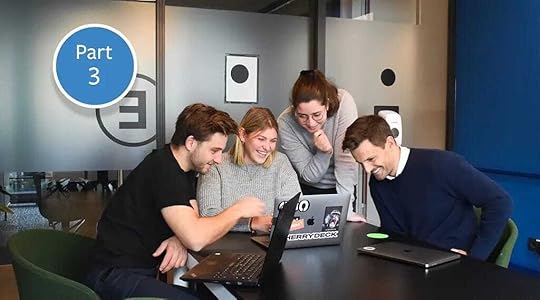
In Part 2 of this series, I discussed ideas and methods. This part covers analysis, focusing on Appreciative Inquiry and Positive Deviance.
Captured knowledge can be analyzed to allow it to be applied in in new and useful ways. Reviewing collected information may reveal patterns, trends, and tendencies that can be exploited, expanded, or corrected. Distilling data to extract the essence leads to discovering new ideas and learning how to improve. Knowledge can be harvested in the form of lessons learned, proven practices, and rules of thumb.
After collected knowledge has been analyzed, it can be codified to produce new standard methodologies, reusable material, and repeatable processes. Data can be consolidated, content can be curated, and processes can be integrated to yield improved business results.
Two specific methods of analysis are especially helpful for knowledge creation. These are Appreciative Inquiry and Positive Deviance.
Appreciative InquiryAppreciative Inquiry (AI) involves asking questions that strengthen a system’s capacity to apprehend, anticipate, and heighten positive potential. It is the mobilization of inquiry through the crafting of the unconditional positive question.
AI is the co-evolutionary search for the best in people, their organizations, and the relevant world around them. In its broadest form, it involves systematic discovery of what gives life to a living system when it is most alive, most effective, and most constructively capable in economic, ecological, and human terms.
As a method of change, Appreciative Inquiry differs from traditional problem-solving approaches. The basic assumption of problem solving is that people and organizations are fundamentally broken and need to be fixed. The process usually involves identifying key problems, analyzing the root causes of failure, searching for possible solutions, and developing an action plan.
In contrast, the underlying assumption of Appreciative Inquiry is that people and organizations are evolving and growing. AI focuses the whole organization on identifying its positive core — its greatest assets, capacities, capabilities, resources, and strengths — to create new possibilities for change, action, and innovation. The steps include discovering the organization’s root causes of success, envisioning bold new possibilities for the future, designing the organization for excellence through dialogue, and co-creating the future.
Use Appreciative Inquiry to evolve from problem solving to innovation. This process can be applied in almost any context, and the philosophy can be applied in communities, training, communications, user assistance, rewards, lessons learned, proven practices, collaboration, and management of change.
The 5 Ds of Appreciative Inquiry
Define — What is the topic of inquiry? It is important to define the overall focus of the inquiry (what the system wants more of). Definition is used to clarify the area of work to be considered. It defines the project’s purpose, content, and what needs to be achieved. In this phase, the guiding question is, “What generative topic do we want to focus on together?”Discover — Appreciating the best of what is. Discovery is based on a dialogue, as a way of finding what works. It rediscovers and remembers the organization or community’s successes, strengths, and periods of excellence.Dream — Imagining what could be. This phase uses past achievements and successes identified in the discovery phase to imagine new possibilities and envisage a preferred future. It allows people to identify their dreams for a community or organization; having discovered what is best. They have the chance to project it into their wishes, hopes, and aspirations for the futureDesign — Determining what should be. Design brings together the stories from discovery with the imagination and creativity from the dream phase. Bring the best of what is together with what might be, to create what should be: the ideal.Destiny — Creating what will be. The fifth phase identifies how the design is delivered, and how it is embedded into groups, communities, and organizations.Positive DevianceUsing Positive Deviance can help find those whose special practices, strategies, and behaviors enable them to find better solutions to prevalent problems than their neighbors who have access to the same resources. Positive Deviance is based on the observation that in any community, there are people whose uncommon but successful behaviors or strategies enable them to find better solutions to a problem than their peers, despite facing similar challenges and having no extra resources or knowledge. It enables a community to discover successful behaviors and strategies and develop a plan of action to promote their adoption by all concerned.
Positive deviants can be found everywhere. Their special practices enable them to find better solutions than their peers to prevalent problems. Study what works and encourage replication by others.
The 6 Ds of Positive Deviance
Define the problem, its perceived causes, related current practices (situation analysis), and what a successful solution or outcome would look like. Describe the desired outcomes as changes in behavior or status. Determine if there are any individuals or entities in community who already exhibit desired behavior or status. Identify the positive deviants. Discover uncommon practices or behaviors enabling the positive deviants to outperform or find better solutions to the problem than others in their community. Design and implement activities enabling others in the community to access and practice new behaviors. Focus on doing rather than transferring knowledge. Discern the effectiveness of activities through ongoing monitoring and evaluation. Disseminate the successful process to appropriate others. This is scaling up.In Part 4 of this series, I will discuss actions to take to create knowledge and provide an example of knowledge creation.
To learn more, please join me for “The Five Cs of Knowledge Management Part 5: Create”, the final webinar in this series presented by Lucidea on Wednesday, June 21, 2023 at 11 a.m. Pacific, 2 p.m. Eastern. Can’t make it? Register anyway to receive a link to the recording and slides afterwards.
 The Five Cs of KM[image error]
The Five Cs of KM[image error]
June 2, 2023
The Five Cs of KM: Create, Part 2 — Ideas and White Papers

In Part 1 of this final series related to the Five Cs of KM, I discussed connection and methods for creation. In this part, I discuss ideas and white papers.
IdeasGood ideas exist throughout any organization but there may not be a good way to capture those ideas. These thoughts may just stop with the people who have them and not go anywhere. However, if you provide a way for those ideas to come forward as suggestions, they may represent opportunities that can be capitalized on for the benefit of everyone.
One approach to capturing ideas is an innovation management system. Some organizations have tools purchased or developed specifically for this function, often referred to as ideation, idea management, or idea creation. This approach offers a vehicle for submitting, tracking, and processing suggestions and ideas, with the goal of acting on the best ones.
Specialized systems for collecting and managing ideas are available as software products. An alternative is to use the existing Enterprise Social Network (ESN), which typically has good capabilities for people to make suggestions. In an ESN, suggestions can be solicited, tagged with a unique identifier, and acknowledged.
In either case, it is important to respond to those who take the time to offer a suggestion. Merely collecting ideas is not enough. People become frustrated if they never see what happens to those ideas. You can use the ESN to reply by thanking all contributors of ideas and explaining what will happen next. There are several possible responses. One is to confirm that a suggestion will be implemented and specify when it will happen. Another is to inform that the suggestion is already in effect or planned. And if the idea is unlikely to be used, an explanation should be provided. Closing the loop is important, even for suggestions that are not accepted. And it is essential to actually implement the best ideas.
Innovation challenges can be used to focus an organization’s attention and energy on knowledge creation. These can be one-time or recurring, with a theme and possibly a set of prizes. For example, a one-month innovation challenge to develop new ways to save on energy costs and consume energy in a more responsible and sustainable way. The goal is to get ideas flowing from as many people as possible, celebrate everyone who participates, and recognize and implement the best suggestions.
The idea behind knowledge creation is not only to collect documents and connect people, but to implement specific processes to stimulate innovation. Inspire people to offer ideas that are not only collected but celebrated and implemented. This results in a responsive organization in which people are recognized for their creativity.
White PapersEstablishing an easy process for white papers to be submitted, reviewed, and published can facilitate knowledge creation. Provide ways to subscribe to new publications in areas of interest, connect with the authors, and collaborate on further enhancements of published ideas. Encourage people to synthesize information from multiple white papers to create new and better methods, tools, and techniques.
An example of a white paper process was Hewlett-Packard’s Knowledge Briefs program. People were encouraged to write white papers on almost any worthwhile topic. The knowledge briefs typically were four or five pages long. This was a way for people to write up an explanation, method, or process so that other people could benefit. There was a formal submission process. To ensure it was useful and well written, a team reviewed each white paper. If it met established criteria it was accepted, published, and disseminated to make subscribers aware so they were able to apply the new knowledge.
An example of a knowledge brief was “How to Ask for Help: 10 Simple Rules” by my HP colleague, Bruce Karney. He documented a method to increase the likelihood of receiving useful answers when asking for help. Bruce wrote this because he had frequently received requests for help with insufficient information about the needs, thus frustrating the people trying to help. He took the time to write a white paper that explained in detail how to improve the odds of receiving assistance in response to requests for help. This is good example of how documenting proven approaches allows other people to read about and apply that knowledge productively.
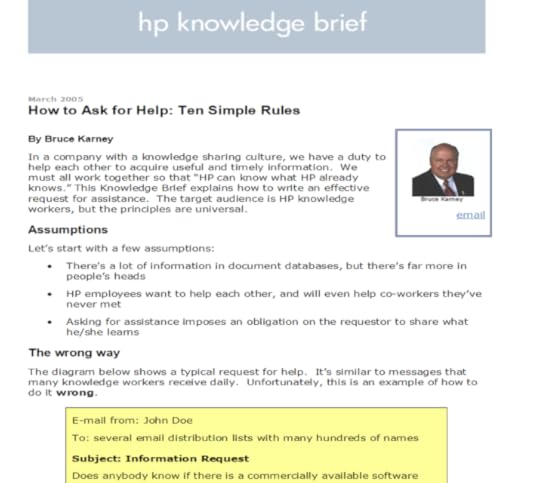
In Part 3 of this series, I will discuss analysis, focusing on Appreciative Inquiry and Positive Deviance.
To learn more, please join me for “The Five Cs of Knowledge Management Part 5: Create”, the final webinar in this series to be presented on Wednesday, June 21, 2023 at 11 a.m. Pacific, 2 p.m. Eastern. Register to attend or to get a link to the recording and slides if you are unable to make it.
 The Five Cs of KM[image error]
The Five Cs of KM[image error]



